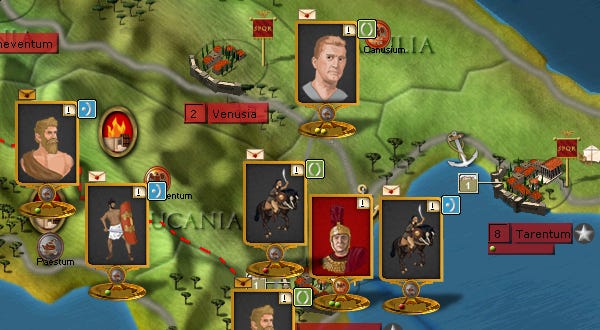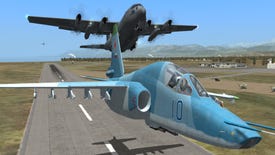The Flare Path: Diecast Romans
Simulation & wargame news
In another life FP was an interpreter attached to Legio XIV Gemina during the Roman invasion of Britain. It was his job to trudge up to the skull-festooned gates of hill forts, usually dodging sling stones and hurled turds as he went, and do the surrender-in-the-name-of-the-Emperor spiel. The answers he carried back to his employers could be long or short, poetic or pithy, but generally they boiled down to the same thing: “We'd rather not, old bean. Attack us and by nightfall your finest warriors will be kissing crows' feet and buggering mouse holes”.
1st century FP ended up genuinely fond of the bolshy British dung chuckers, a fact that might explain why his 21st Century manifestation is mildly disappointed by the lack of Caratacus and Boudica scenarios in Ageod's latest historical gem.
Unleashed tomorrow, Alea Jacta Est's primary focus is the various civil wars that convulsed the Roman Empire between 87 BC and 200 AD. Cough up the not unreasonable 20 GBP and you get - if my preview build is to be trusted - six chunky/replay-friendly scenarios ranging from an evening-sized 25-turn 'Year of the Four Emperors' challenge. to a week-warranting 129-turn Caesar vs. Pompey epic. All of the scenarios can be played from multiple perspectives, and the larger ones utilize every province on the game's vast and handsome Britain-to-Babylonia, Norway-to-Numidia map.
Thus far, I've spent most of my time in the sandals of a rebellious gladiator called Spartacus and a vain yet principled emperor called Ortho. Enemy armies have handled themselves alarmingly well, and campaigns have rung with historical echoes. The feel is unmistakeably Ageod (if you've played the likes of Birth of America II and Revolution Under Siege, you'll settle in swiftly) but a host of new rules and tweaks, and the copious research that has plainly gone into the scenarios, ensures the era shift doesn't feel forced or cynical.
Never tried an AGE-engined title before? Play mostly consists of splitting and merging armies, then giving those armies destinations and combat stances (attack vigorously, attack cautiously defend, evade... etc). Because the results of orders are calculated at the end of turns, the action can feel a little arms-length at first. You press the End Turn button and watch, helpless, as forces canter across the cartography, occasionally colliding and kicking the Strength Points out of each other. Until you grasp the significance of those combat stances, and come to understand the detailed battle results summaries, you can expect to be as mystified as you are mesmerised.
Happily, the Greenlight-hungry Alea Jacta Est isn't just another game about building monster stacks of Praetorians and force-marching them towards victory locations. Size and troop quality is important of course, but more often than not battle results are determined by a swarm of less obvious factors. The leader you've placed at the head of a force is massively significant. A set of strong offensive and defensive stats and a selection of impressive history-based personality traits can - as Mr. Spartacus has proved to me time and time again - be worth thousands of spears and swords. Fatigue, supply status, weather, terrain, cohesion, force composition, experience, luck, morale, combat stances... they can all decide battles.
Scraps themselves are represented by the blink-and-you'll-miss-it Battle Circle, a kind of slaughter swingometer. To understand exactly why your force of escaped skivvies and uppity farmhands managed to outfight some of Rome's finest professional soldiers, you need to study the lines of tiny tooltipped icons on the results screen. Ah, the opposing general was a drunken sot who deployed and led his weary, dispirited troops poorly... my defensive stance meant I held the high ground during the battle... they chose to attack across a river... There's fascinating and useful information there for those prepared to search for it.
The brief text summaries of engagements are not always especially useful. Take the one below for example (click for a closer look). This 'victory' effectively demolished my second-largest slave army. The prospects for Kirk Douglas and co. are now decidedly bleak.
Inevitably the Ageod games are compared with Paradox titles on occasion. There is plenty of common ground but the French studio has always been more interested in the military than the political and civic. Alea Jacta Est fractures the mould somewhat by offering dozens of different governmental and developmental tools. Mostly funded by cash or 'engagement points' (a political currency), the options include organising morale-boosting ampitheatre events and loyalty-bolstering propaganda campaigns to bribing chieftains and building aqueducts. Presently I'm a little concerned that the expanded civil side distracts rather than enhances, but that feeling may well pass as I get more familiar with the new instruments.
Whether my scenario selection and unit portraiture complaints are still relevant a month from now, depends a lot on Ageod's art and mission people. In the preview build many generals share the same marker portraits which can lead to confusion. More significantly, Alea Jacta Est is yet another wargame disappointingly short of small evening-sized introductory challenges. Some brief Northern tribe-suppressing mini-campaigns perhaps - even if they were semi-fictional - would have been a boon for newcomers looking to transition from the trim tutorials to the continent-spanning splendour of the large multi-year scenarios.
The Flare Path Foxer
...is in quarantine this week with suspected rabies. Sorry. Back next week.




















